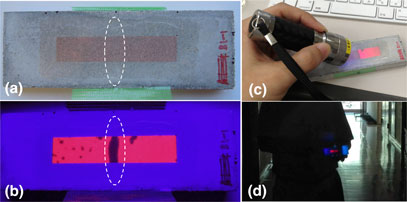No CrossRef data available.
Published online by Cambridge University Press: 29 April 2019

Luminescent oxygen sensor composed of platinum-porphyrin and a gas-permeable polymer binder was applied as an optical crack sensor paint for infrastructure. The sensor paints were designed as a three-layered structure in which the luminescent oxygen sensor layer was sandwiched between oxygen barrier layers. The sensor paints emitted intense luminescence under UV light irradiation, and the luminescence was efficiently quenched when a new crack formed on the concrete surface. Microcracks, which were <0.1 mm width and hardly visible to the naked eye, were clearly visualized under UV light irradiation due to the luminescent quenching caused by oxygen diffusion.